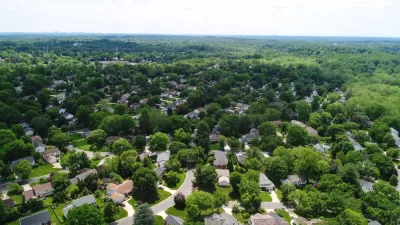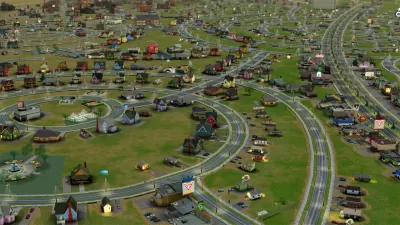Smart growth supporters tend to prefer grid systems to cul-de-sacs, for excellent reasons. A proliferation of cul-de-sacs artificially lengthens walking distances: if streets don’t connect to each other, you might have to walk a mile to go just a few hundred feet. In addition, cul-de-sacs increase traffic congestion by dumping most vehicular traffic on a few major streets. And because biking is less safe on busy, high-traffic streets, bikers benefit from a grid system as well.
Smart growth supporters tend to prefer grid systems to cul-de-sacs, for excellent reasons. A proliferation of cul-de-sacs artificially lengthens walking distances: if streets don't connect to each other, you might have to walk a mile to go just a few hundred feet. In addition, cul-de-sacs increase traffic congestion by dumping most vehicular traffic on a few major streets. And because biking is less safe on busy, high-traffic streets, bikers benefit from a grid system as well.
But banning cul-de-sacs on residential streets might go too far: many homeowners understandably prefer cul-de-sacs because of the absence of "cut through traffic" on those streets (that is, traffic cutting through from one major street to another). Is there a middle ground between current subdivision ordinances (which sometimes require new subdivisions to be dominated by cul-de-sacs) and wiping out cul-de-sacs altogether?
One option might be for government to neither encourage nor discourage cul-de-sacs. It seems to me that this result would clearly be preferable to the status quo, as it maximizes consumer choice while reducing at least some of the social harms caused by cul-de-sacs.
On the other hand, one common justification for government regulation is to prevent situations where it makes sense for individuals to do X, but if lots of individuals do X, we all lose something. It could legitimately be argued that the prevalence of cul-de-sacs may be such a situation: if I live on the only cul-de-sac in the neighborhood, I have less traffic on my street (presumably a good thing) but still live in a basically walkable and uncongested neighborhood. But if everyone else lives on a cul-de-sacs, I have to suffer through all the disadvantages of cul-de-sacs as well: more traffic congestion because everyone has to drive on a couple of main streets, and reduced walkability as distances between houses multiply.
A second "middle ground" alternative is to allow cul-de-sacs in new subdivisions, but to create a quota limiting their number- for example, to provide that there be no more than one cul-de-sac for every intersection.This rule might accommodate consumer demand for cul-de-sacs, but would ensure that there were enough interconnected streets to accommodate driving, walking and biking.
A third compromise is the "fused grid." Under a fused grid street system, there is a grid of main streets and a set of cul-de-sacs branching off from those streets. But the difference between the fused grid and a cul-de-sac system is as follows: in the latter situation, there is nothing to connect one cul-de-sac to another, so walkers and bikers have to travel out of their way to reach other cul-de-sacs. By contrast, a fused grid "fuses" the cul-de-sacs with miniature parks or pathways designed for bicycles and pedestrians, thus allowing nondrivers to go from one house to another. When streets in an existing grid network are closed off to cars, something similar to a fused grid is created: cars are limited as in a cul-de-sac system, while pedestrians are as mobile as in a grid system.

Manufactured Crisis: Losing the Nation’s Largest Source of Unsubsidized Affordable Housing
Manufactured housing communities have long been an affordable housing option for millions of people living in the U.S., but that affordability is disappearing rapidly. How did we get here?

Americans May Be Stuck — But Why?
Americans are moving a lot less than they once did, and that is a problem. While Yoni Applebaum, in his highly-publicized article Stuck, gets the reasons badly wrong, it's still important to ask: why are we moving so much less than before?

Research Shows More Roads = More Driving
A national study shows, once again, that increasing road supply induces additional vehicle travel, particularly over the long run.

Judge Halts Enforcement of Anti-Homeless Laws in Grants Pass
The Oregon city will be barred from enforcing two ordinances that prosecute unhoused residents until it increases capacity and accessibility at designated camping sites.

Advancing Sustainability in Los Angeles County Schools
The Los Angeles County Office of Education’s Green Schools Symposium brings together educators, students, and experts to advance sustainability in schools through innovative design, climate resilience strategies, and collaborative learning.

Using Old Oil and Gas Wells for Green Energy Storage
Penn State researchers have found that repurposing abandoned oil and gas wells for geothermal-assisted compressed-air energy storage can boost efficiency, reduce environmental risks, and support clean energy and job transitions.
Urban Design for Planners 1: Software Tools
This six-course series explores essential urban design concepts using open source software and equips planners with the tools they need to participate fully in the urban design process.
Planning for Universal Design
Learn the tools for implementing Universal Design in planning regulations.
City of Moreno Valley
Institute for Housing and Urban Development Studies (IHS)
City of Grandview
Harvard GSD Executive Education
NYU Wagner Graduate School of Public Service
City of Cambridge, Maryland
Newport County Development Council: Connect Greater Newport






























